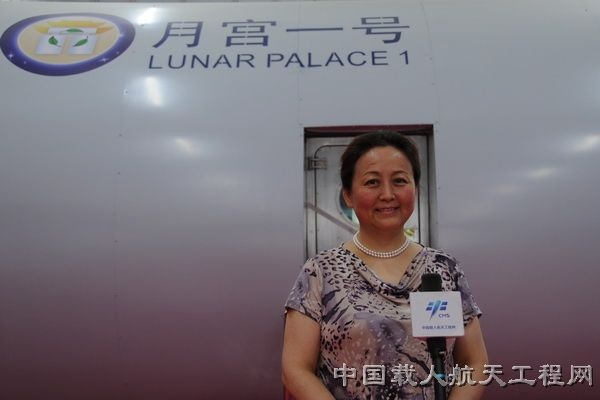China's 'Lunar Palace' for Space Research Tested on Earth


Three volunteers stepped out of China's Lunar Palace 1 last month after a 105-day shakeout mission — not on the moon, but on Earth.
Munching on protein-rich mealworms and other delicacies, the trio of Chinese biospherians carried out the first long-duration multicrew sealed cabin research in the country at the Beijing University of Aeronautics and Astronautics.
China's Lunar Palace 1, developed by researchers at Beihang University in Beijing, is short for the Integrative Experimental Facility for Permanent Astrobase Life-support Artificial Closed Ecosystem (PALACE) Research. [Learn more about China's space program]
Experimental crops
The facility is a 500-cubic-meter capsule that covers an area of 160 square meters and consists of one integrated module and two plant cultivation modules. The integrated module includes a living room, a work room, a bathroom and a waste-disposal room.
Experimental crops, such as corn and peanuts, were grown during the test, as were lentils and cucumber vine plants.
Human waste was handled within the Lunar Palace 1 by a biofermentation process. Food residue and other byproducts were treated by biotechniques and were used for plant cultivation.
Breaking space news, the latest updates on rocket launches, skywatching events and more!
The three-person team comprised two women — Xie Beizhen and Wang Minjuan — and one man, Dong Chen, all from the Beijing University of Aeronautics and Astronautics.
The Lunar Palace 1 project started in March 2013 with system construction, followed by the commissioning of the facility, leading up to the 105-day mission that ended May 20.
Ecological life support
Officials from the China Manned Space Engineering (CMSE) office said, "The success of the experiment has laid [a] good foundation to CELSS [the controlled ecological life support system] flight demonstration tests for China's space station, which will be helpful for China's astronauts to get fresh vegetables, improve their living conditions and relieve their mental stress."
The core of Lunar Palace 1 is the world's most advanced closed-loop life-support technology so far: a Bioregenerative Life Support System that is essential for astronauts to live and work in space for long-duration missions, thus making it possible for lengthy spaceflights and planetary exploration, representatives wrote on the CMSE website.
A story posted on the CMSE website says Lunar Palace 1 is the first bioregenerative life-support base developed in China, and the third overall in the world.
"The success of Lunar Palace 1 research indicates that China has been among the most advanced in the field of bioregenerative life-support research, which will play a significant role in China's future missions like [a] manned moon landing, lunar base establishment, Mars exploration," the website states.
"I think the biggest significance of this system is the ability to provide the necessary theoretical basis and technical support for a lunar base," Liu Hong, chief architect of Lunar Palace 1 and a professor of biological and medical engineering at Beijing University of Aeronautics and Astronautics, said.
Long journey ahead
MIT's Larry Young is a research scientist that has been focused on life support issues facing astronauts on long-duration space travel, particularly the use of artificial gravity. Last year, Young took part in a China-sponsored space life sciences meeting and got a first-hand look at what that country's top experts are considering in terms of their future space exploration activities.
"China's Lunar Palace 1 gives an entirely new meaning to 'Chinese takeout,'" said Larry Young, Apollo program professor of astronautics and professor of health sciences and technology at the Massachusetts Institute of Technology in Cambridge, Mass.
Only with an efficient, fully closed biologically regenerative life-support system can we seriously move forward with an anticipated human Mars exploration, Young told Space.com.
"We still have a long way to go before space crews can live entirely on food raised in their onboard gardens," Young said, "but this long journey has, as Confucius might have said, started with the first step."
Leonard David has been reporting on the space industry for more than five decades. He is former director of research for the National Commission on Space and is co-author of Buzz Aldrin's 2013 book, "Mission to Mars – My Vision for Space Exploration," published by National Geographic. Follow us @Spacedotcom, Facebook and Google+. Original article on Space.com.

Leonard David is an award-winning space journalist who has been reporting on space activities for more than 50 years. Currently writing as Space.com's Space Insider Columnist among his other projects, Leonard has authored numerous books on space exploration, Mars missions and more, with his latest being "Moon Rush: The New Space Race" published in 2019 by National Geographic. He also wrote "Mars: Our Future on the Red Planet" released in 2016 by National Geographic. Leonard has served as a correspondent for SpaceNews, Scientific American and Aerospace America for the AIAA. He has received many awards, including the first Ordway Award for Sustained Excellence in Spaceflight History in 2015 at the AAS Wernher von Braun Memorial Symposium. You can find out Leonard's latest project at his website and on Twitter.



